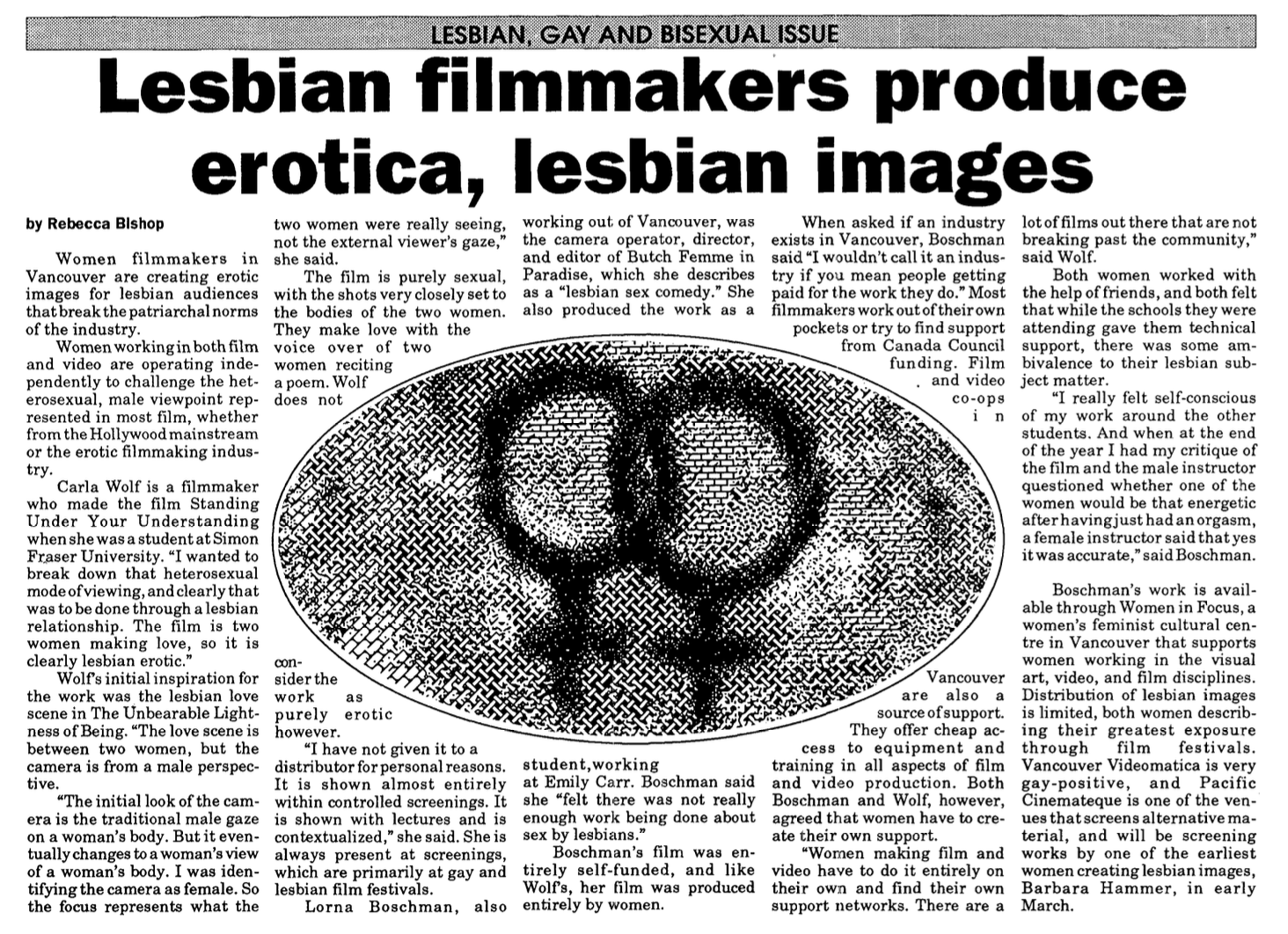Nestled in the archives of the UBC Library is a copy of the Vancouver newspaper Kinesis, which was run by the Vancouver Status of Women from 1974–2001.
The May 1, 1999, Mother’s Day special issue included news updates, arts and culture, resources for women and personal stories about what it is like to be a mother — including some narratives from Queer women.
“I remember thinking, when I knew I was a lesbian, ‘I want to have more kids,’ and trying to figure out how that would work,” wrote Lisa Geller, a mother of three and middle management worker.
She described her life raising her children with her partner. Despite being a lesbian at a time when it was less socially accepted, she never internalized any hostility.
“I don’t feel particularly judged from outside. The things they would judge me about — like being a lesbian — I’m very secure about.”
The paper also included advertisements for a Lesbian and Gay bookstore on Davie Street (Vancouver’s historically gay neighbourhood), a New York-based Gay Muslim Conference and classified ads from people looking for roommates.
A quick search through UBC Archives turns up a plethora of materials about the 2SLGBTQIA+ community — Pride-themed Ubyssey newspapers, posters for the Fourth Annual Gay Conference and vintage erotica, to name a few.
There is a record of ways 2SLGBTQIA+ people found and interacted with their community through print — books, flyers or newspapers and more — before the internet could connect them to each other.
“In terms of just the spread of information, print culture has always been essential for sexual minority communities,” said Dr. Gregory Mackie, a UBC English professor, in an interview with The Ubyssey.
Mackie is also a curator for UBC Library’s Rare Books and Special Collections and part of the Queer Collections Project, which acquires archival materials from 1869 to around 1969.
UBC’s Queer Collections Project strives to make a diverse array of Queer primary sources — like rare historical printed books, ephemera, letters, artwork, diaries and other historical documents — available to students.
Mackie said the Queer Collections Project recently received a grant from the VP Students Office to aid in its curation.
“The materials we hope to acquire naturally go far beyond the gay male experience,” read the Queer Collections Project website. “Our goal is to ensure that the project’s acquisitions address wide arrays of experience, including early engagements with intersex and trans* histories.”
Community through print media
Mackie said print allowed 2SLGBTQIA+ people to communicate efficiently and anonymously, sometimes hiding in plain sight when it would have been dangerous — or illegal — to be out. Activist groups also used magazines and pamphlets to organize against homophobic laws.
One example is the ASK newsletter published by the Vancouver-based Association for Social Change (ASK), BC’s first gay rights group.
“People who weren’t necessarily in the know could sometimes look at this material and not really understand [the name],” said Mackie. That way, it could fly under the radar.
The newsletter called for the decriminalization of homosexuality but later began publishing poetry and notices for community events. Still, pieces were often anonymous.
The Ubyssey’s 1991 “Lesbian, Gay and Bisexual” newspaper issue included pieces about local lesbian filmmakers making erotica, the role of disco in gay subculture and frustration around the Canadian government’s lack of action to include sexual orientation in the Charter of Rights and Freedoms.
This issue also featured anonymous stories from 2SLGBTQIA+ students. One titled “Why do people tell me they are lesbian/gay?” explored a student’s experience with straight friends questioning the act of coming out.
They responded that they come out “because I want you to see that your stereotypes are wrong; because I want to be open with you; because I want you to ask me about being gay.”
“Oh yeah, I almost forgot... because I would like to sign this but I know that if I do it will hurt my career … and I hope that someday, with your help, I won’t have to worry anymore.”
Pushed into the upper corner of one of the last pages in the issue is a personal essay titled “Overcoming fear, becoming whole” written by an unnamed student.
“I never hid in closets as a child, and somehow I do not think I am prepared to do so as an adult,” read the article. “So I finally come to acknowledge that I am attracted to women, and I accept it. It’s okay, in fact it is great.”
Another local record obtained by the Queer Collections Project is a 1972 booklet titled A Guide for the Naive Homosexual.
“It’s a chunky pamphlet that was self-published by this guy, and he would sell it by mail order to people moving into Vancouver,” said Mackie.
Mackie said the pamphlet described what it was like to live a gay life in Vancouver, including information about coming out, where to meet people and the levels of harassment faced by 2SLGBTQIA+ people from police and others in the city.
“It was really, really essential for a lot of people,” said Mackie.
Surveying the collection, which contains materials spanning a century, Mackie said one of the trends seen over the years is a “greater degree of openness, a greater degree of risk-taking.”
“[We’ve seen] Queer people getting a lot more pushy, which is really amazing to see the amount of bravery and the amount of chutzpah that it took for this material to be produced and to be circulated. People were taking a lot of risks, often.”
For Mackie, the Queer Collections Project aims to make these histories accessible to students.
“We have students who think this is something new, and that their [Queer] experience isn’t connected to a lot … They’re sort of aware, but less so, right?” said Mackie. “Their experiences [are] actually connected to a much longer history.”
— With files from Chelsea Shriver





